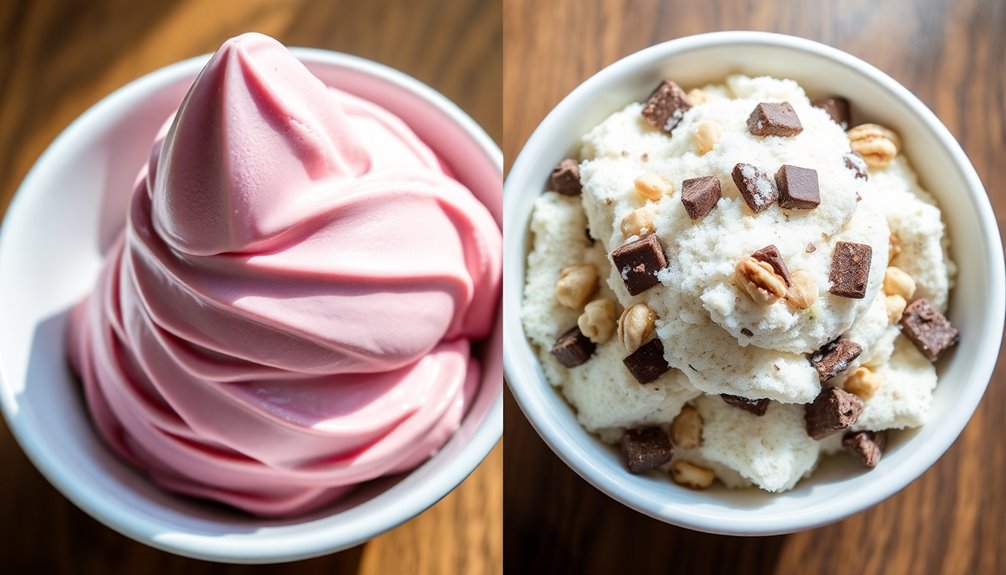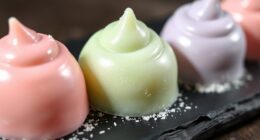When choosing between churned and no-churn ice cream techniques, consider your time and desired texture. Churned ice cream uses a custard base, giving it a rich, creamy texture, but requires more effort and special equipment. In contrast, no-churn ice cream relies on sweetened condensed milk, making it a quick and easy option without the need for churning. Each method has its charm, and you might just discover which one suits your ice cream cravings best. Explore the details further!
Key Takeaways
- Churned ice cream uses a custard base for depth and richness, while no-churn relies on sweetened condensed milk for simplicity and speed.
- The churned method incorporates air, resulting in a denser and creamier texture compared to the lighter, airier no-churn version.
- No-churn ice cream can be prepared in about 10 minutes, making it accessible for those without ice cream makers.
- Churned ice cream requires more complex steps, including cooking and cooling a custard base, before being churned and frozen.
- Flavor experimentation is encouraged in both methods, allowing for personalized ice cream creations based on individual taste preferences.
Understanding Ice Cream Techniques

When you plunge into the world of ice cream, you’ll quickly notice two distinct methods: churned and no-churn.
Traditional churned ice cream involves a custard base of heated cream, milk, sugar, and egg yolks, giving it a rich flavor and smooth texture. The churning process incorporates air, making it denser and creamier.
Traditional churned ice cream features a custard base that yields a rich flavor and velvety texture, enhanced by the churning process.
On the other hand, no-churn ice cream simplifies things by mixing sweetened condensed milk with whipped cream, allowing you to whip up a chocolate delight in about 10 minutes without special equipment.
However, the flavor can lean towards overly sweet due to the high sugar content in the condensed milk. Balancing your ingredients is key; a common ratio is three parts heavy cream to two parts sweetened condensed milk for the best texture.
The No-Churn Method Explained

When you want to whip up a delicious treat without the fuss, the no-churn method is your best friend.
With just four simple ingredients and about 10 minutes of prep time, you can create a delightful ice cream that’s both easy and quick.
Forget the ice cream maker; this technique makes it accessible for anyone to enjoy homemade ice cream.
Ingredient Simplicity
Although many traditional ice cream recipes can be complex and require specialized equipment, the no-churn method simplifies the process with just four main ingredients: heavy cream, sweetened condensed milk, flavorings, and a pinch of salt.
This straightforward approach makes it accessible for home cooks who want delicious ice cream without the hassle. By using sweetened condensed milk, you not only add sweetness but also help achieve a creamy texture that rivals churned versions.
Plus, this no-churn technique eliminates the need for an ice cream maker, ice, and salt, making it even more convenient. In just about ten minutes, you can whip up a delightful treat that’s lighter and airier, perfect for any occasion.
Quick Preparation Time
The no-churn method not only simplifies ingredient selection but also cuts down on preparation time, making it an appealing choice for those craving homemade ice cream.
With just four ingredients, you can whip up delicious no-churn ice cream in about 10 minutes. No special equipment is needed, so anyone without an ice cream maker can create a delightful frozen dessert at home. Additionally, this method allows for a variety of savory ingredients to be incorporated, enhancing the overall flavor profile. In fact, ice cream consumption in the U.S. reaches about 23 pounds annually per person, highlighting the widespread appeal of this frozen treat.
The secret ingredient, sweetened condensed milk, not only adds sweetness but also gives the ice cream its creamy texture.
Although it requires about 8 hours to fully freeze, the quick preparation time allows you to enjoy a variety of flavors and mix-ins without the hassle. Additionally, you can pair your ice cream with freshly squeezed juices to enhance the flavor experience.
Immerse yourself in the no-churn trend and satisfy your sweet tooth effortlessly!
Churned Ice Cream Process

To create churned ice cream, you start by making a custard base that combines heated cream and milk with egg yolks and sugar for a rich flavor.
After preparing your custard, cool it to about 38°F before you process it in your ice cream machine. This step is essential for achieving that creamy ice texture.
Here’s how to proceed:
- Mix heated cream, milk, egg yolks, and sugar to form custard ice.
- Cool the custard base thoroughly.
- Pour the mixture into the ice cream machine and churn to incorporate air.
- Freeze for about 8 hours for the perfect firmness.
Churned ice cream gives you a superior flavor profile, thanks to the controlled sweetness and creaminess.
Comparing Texture and Consistency

When you compare churned and no-churn ice creams, you’ll notice distinct differences in texture and consistency.
Churned ice cream usually has a denser, creamier feel thanks to the air incorporated during the churning process, while no-churn varieties often come out lighter and airier.
Understanding these differences can help you choose which method suits your taste and texture preferences best.
Texture Differences Explained
While both churned and no-churn ice cream offer delightful cold treats, their textures differ significantly. You’ll likely notice these key differences:
- Churned Ice Cream: Denser and creamier, thanks to air incorporation during the churning process, resulting in fewer ice crystals.
- No-Churn Ice Cream: Lighter and airier, resembling whipped cream or frozen mousse, primarily due to whipped heavy cream.
- Traditional Ice Cream Similarity: The texture of churned ice cream closely resembles traditional ice cream, providing a rich mouthfeel.
- Sweetened Condensed Milk Impact: In no-churn ice cream, sweetened condensed milk can create a sticky texture that some find less appealing compared to the balanced texture of churned varieties.
Your texture preference might sway between these two styles based on personal taste!
Consistency of Ice Cream
Churned and no-churn ice creams not only differ in texture but also in their overall consistency.
Churned ice cream tends to have a denser, creamier mouthfeel, thanks to the incorporation of air during the churning process. This method provides a more traditional texture that holds up well in the freezer, maintaining its quality over time.
On the other hand, no-churn ice cream often has a lighter, airier consistency, sometimes reminiscent of whipped cream or frozen mousse. However, the use of ingredients like sweetened condensed milk can lead to an overly sweet and less stable texture.
Ultimately, whether you prefer the rich creaminess of churned ice cream or the fluffiness of no-churn options depends on your personal taste.
Flavor Profiles: No-Churn vs. Churned

Although both churned and no-churn ice creams offer delightful frozen treats, their flavor profiles differ considerably.
Churned ice cream provides a rich, balanced experience, while no-churn ice cream often leans heavily on the sweetened condensed milk flavor.
Churned ice cream offers a harmonious blend of flavors, whereas no-churn often emphasizes the sweetness of condensed milk.
Here’s what you can expect from each:
- Churned Ice Cream: Rich flavor profile with enhanced complexity and smoother texture due to air incorporation.
- No-Churn Ice Cream: Dominantly sweet, often tasting more like a frozen dessert, with a lighter, airier texture.
- Flavor Control: Churned recipes allow for precise sweetness and flavor balance.
- Ingredient Integration: Churned ice cream better integrates flavors like vanilla or fruits, leading to a deeper taste.
Ease of Preparation and Assembly

When it comes to making ice cream, the ease of preparation can greatly influence your choice between churned and no-churn methods.
No-churn ice cream shines in convenience, requiring just four ingredients and about 10 minutes of assembly. You don’t need any special equipment; simply whip the cream and fold in sweetened condensed milk.
This straightforward process eliminates the cooking and cooling steps found in traditional churned ice cream, which involves making a custard base that’s more time-consuming.
Both methods have similar freezing times of around 8 hours, but the simplicity of no-churn recipes makes it a go-to for quick homemade ice cream. If you’re short on time, this method will satisfy your ice cream cravings with minimal effort.
Personal Preferences and Recommendations

Many ice cream lovers find their preferences split between the rich sweetness of no-churn varieties and the creamy balance of churned options.
If you’re unsure which one to choose, consider these recommendations:
- Churned Ice Cream: Enjoy the superior texture and complex flavors that come from the traditional method.
- No-Churn Ice Cream: Perfect for quick, easy desserts without the need for special equipment.
- Flavor Experimentation: Combine elements from both techniques to create unique flavor profiles.
- Personal Preference: Ultimately, your choice should reflect your taste—whether you crave a richer, sweeter flavor or a smoother, creamier texture.
Frequently Asked Questions
What Is the Difference Between Churned and Not Churned Ice Cream?
When you compare churned and no-churn ice cream, you’ll notice key differences in texture and preparation.
Churned ice cream uses an ice cream maker to create a creamy, dense texture by incorporating air. In contrast, no-churn ice cream combines whipped cream and sweetened condensed milk, resulting in a lighter, often sweeter dessert.
While both require similar freezing times, the flavors and mouthfeel vary, with churned typically offering a richer taste experience.
Is No Churn Ice Cream Any Good?
You’ll find no-churn ice cream to be a convenient and quick dessert option.
It’s easy to whip up with just a few ingredients, making it perfect for last-minute cravings.
However, you might notice it has a lighter texture and can be a bit sweet due to the condensed milk.
While it’s tasty, you may miss the rich flavor and creamy consistency of traditional ice cream.
Does Churning Ice Cream Longer Make It Better?
Churning ice cream longer doesn’t make it better. In fact, if you churn too long, you risk creating a grainy texture from over-formation of ice crystals.
You want to aim for that 20 to 30-minute mark to keep the right balance of air and creaminess. If you overdo it, you’ll end up with a denser product that loses its delightful lightness.
Is Slow Churned Ice Cream Better for You?
When you consider whether slow churned ice cream is better for you, it often comes down to its ingredients and texture.
You’ll find that it generally contains less air, making it denser and potentially more satisfying, so you mightn’t need a large serving.
Plus, many varieties have lower fat and sugar content, making them a great choice if you’re watching your calorie intake.
Conclusion
In the end, whether you choose churned or no-churn ice cream, it’s like picking your favorite adventure. Churned ice cream is the thrilling roller coaster, with its creamy texture and complex flavors, while no-churn is the leisurely stroll, easy and convenient. Both have their merits, just like every ice cream lover has their own taste. So, grab your spoon and immerse yourself in whichever method speaks to you—after all, life’s too short not to indulge!










